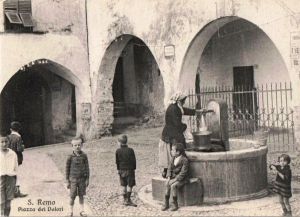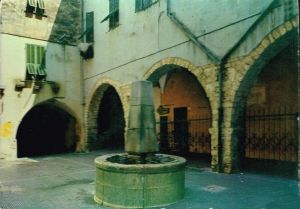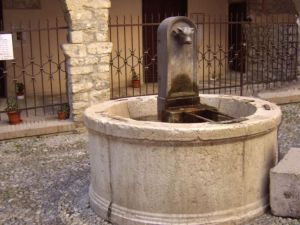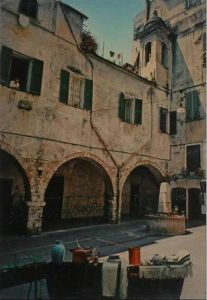The fountain in Piazza dei Dolori
The fountain is one of the first four to benefit from the water coming from Mayor Siro Andrea Carli's aqueduct.
Below is a personal testimony by Giacomo Mannisi (a scholar of Sanremo history) which also describes its history well:
 « I turn and turn in my hands an old postcard of Sanremo, the caption reads "Sanremo as it was" it is the photograph of Piazza dei Dolori, formerly dedicated to San Sebastiano, one of those black and white photos that take you back to the past years when everything had another flavour and looked more beautiful.
« I turn and turn in my hands an old postcard of Sanremo, the caption reads "Sanremo as it was" it is the photograph of Piazza dei Dolori, formerly dedicated to San Sebastiano, one of those black and white photos that take you back to the past years when everything had another flavour and looked more beautiful.
The square is certainly one of the most beautiful and characteristic of Sanremo, I remember when I was a kid, in the first television dramas the squares of the small villages were represented just like that.
In the middle there was a fountain where the women went to get water and stopped to make ciapeti with the other housewives, all around there were three or four storey high buildings that did not prevent the sun rays from filtering and warming the days of the children, who could play quietly because there were no cars or other dangers, At a certain time of day, their mothers would call them to come home from the same windows that they also used to spy on passers-by or neighbours who, in the case of strange situations, became the subject of chatter when they met at the wash-house or in the churchyard on Sunday mornings after mass.  The fountain in the photograph, however, is not as I remember it from the early 1960s when, as a child of about four or five, I was taken to Sanremo, which from then on became my adopted city; I remember a sort of well with a small pinkish-white stone obelisk in the centre.
The fountain in the photograph, however, is not as I remember it from the early 1960s when, as a child of about four or five, I was taken to Sanremo, which from then on became my adopted city; I remember a sort of well with a small pinkish-white stone obelisk in the centre. Today, however, the fountain in Piazza dei Dolori is again as depicted in the postcard that I jealously hold in my hands. The well is still the same, but in the centre, instead of the obelisk, there is a cast iron casting with a bull's head, which to tell the truth has very little to do with the bull, and from which a small continuous jet of water comes out.
Today, however, the fountain in Piazza dei Dolori is again as depicted in the postcard that I jealously hold in my hands. The well is still the same, but in the centre, instead of the obelisk, there is a cast iron casting with a bull's head, which to tell the truth has very little to do with the bull, and from which a small continuous jet of water comes out.
The current arrangement took place in the 1990s, when, as the square was being rebuilt to repair the sewage pipes and reposition the cobblestones, with the passageway marked in the middle by red bricks, with the intention of restoring the square to its former glory, the people in charge of the work decided to contact the Turin factory which, as luck would have it, still had the mould for casting the central part of the fountain in cast iron, and they had a copy cast especially for them, which they placed on site with the pride of those who thought they were doing a worthy job.
 When the work was finished, however, instead of receiving expressions of gratitude, they were strongly contested by those who knew perfectly well that the fountain in the photo was not the one originally designed, but a remake due to the desire to pay homage to the Savoy family, who, as lords of Turin, had seen the Genoese Republic, including San Remo, assigned to the Kingdom of Sardinia in 1815 (Congress of Vienna).
When the work was finished, however, instead of receiving expressions of gratitude, they were strongly contested by those who knew perfectly well that the fountain in the photo was not the one originally designed, but a remake due to the desire to pay homage to the Savoy family, who, as lords of Turin, had seen the Genoese Republic, including San Remo, assigned to the Kingdom of Sardinia in 1815 (Congress of Vienna).
Unfortunately, when they wanted to redo the fountain as shown in the photo, they didn't take into account that obelisks are a sort of trademark for Sanremo, since it tells the legend of Captain Bresca who, at the risk of his own life, contributed in a decisive way to the erection of the obelisk of Saint Peter's Square in Rome in 1586 and of which the people of Sanremo are extremely proud.
When in 1828 the mayor of Sanremo Siro Andrea Carli, Carlandria for the people of Sanremo, decided that it was time for his city to have a water supply system that would allow a standard of living more in line with the needs of his time, he decided to build an aqueduct that, bringing water from Lake Negro, under the slopes of Mount Bignone, would flow into the four most important city squares through fountains designed for the occasion.
The squares were: Piazza Santo Stefano (today known as Piazza Nota), overlooked by the former town hall; Piazza del Mercato, the place where the citizens met par excellence; and Piazza dei Dolori.
Later, the one in Piazza Bresca was built, the one that connected the city to the sea, and in memory of Captain Benedetto Bresca, was placed the stele most similar to the obelisk of St. Peter, but also Piazza Nota has a central pillar, Piazza del Mercato, today Piazza Eroi Sanremesi, had a stone, on which was later placed the statue of Carlandria, this assumes that even Piazza dei Dolori, although there are no documentary evidence, had in the centre of the pool something similar to an obelisk.
Probably at the end of the 19th century the original fountain was replaced by the 'bull' immortalised in the postcard; in the first half of the 20th century there was a new replacement with the obelisk that I still remember, which, if it was not the original, is as close as one can get to it; and finally in the 1990s the last replacement with the bull's head that we can still see today.
At this point, all that remains is to wonder what happened to the small pinkish-white stone obelisk that I remember; anyone wishing to take a walk to the Hermitage of St Michael could easily see it in the middle of a strip of road, a few dozen metres before the little church, standing looking down on a city that, without a hint of gratitude, has abandoned it ».




